Implications of Urban Land Management on the Cooling Properties of Urban Trees: Citizen Science and Laboratory Analysis
Abstract
:1. Introduction
2. Materials and Methods
2.1. Study Sites
2.2. Field Measurements by Citizen Scientists
2.3. Laboratory Analysis
2.3.1. Leaf Dimensions Computation
2.3.2. Allometric Relationships at Leaf and Shoot Scales
2.3.3. Reconstruction of Trees, Estimate of Tree Metrics, and Simulations
2.3.4. Statistical Analyses
3. Results
3.1. Field Measurements and Leaf Dimensions
- The time dedicated by the citizen scientists to data collection was of a total of 70 h (14 sessions, each one lasting two and a half hours), during which the citizen scientists gathered data and fresh samples of nearly 2500 leaves and 360 shoots (Table 2) from the three sites. If travelling time to the study sites is considered (two days per session, in average), then the total time that two researchers would have taken to collect the leaf data and samples would have been an entire month (around 240 h).
- At the leaf scale, the mean LA, LL2, and LW differed significantly among the management practices at the CH and LF sites (Figure 3). The leaves of the UM trees and the MA trees were smaller than the other management practices in these two sites.
- At the shoot scale in all sites, the management practice significantly affected the total leaf area held by a single shoot. The mean TLA was significantly higher in the MA (CH and KG) and HM (LF) trees (Figure 4). The same applies for NL at the CH and LF sites only. The SL was significantly higher in the HM trees at the LF site only.
3.2. Allometric Relationships
- At the leaf scale, LA was significantly related to LL2 (Equation (3)), with a significant interaction with the management practice (Figure 6) at LF sites. The same applies at the CH site, but at the p < 0.1 level. The LW was linearly and significantly related to LL, but a significant interaction with the management practice was detected at the LF site only. The management practice affected leaf shape mainly at the LF sites, and at the CH site to a lower extent.
3.3. Reconstruction of Leaf Area and Model Simulations
- Total leaf area (TLA) ranged from 41.7 m2 (UM trees at Cannon Hill Park) to 95.7 m2 (MA trees at KG) while the projected leaf area (PLA) ranged from 11.3 m2 to 15.1 m2. The leaf area indices (LAI) ranged from 11.3 to 15.1. This hierarchy was kept for the number of voxels (thus as well for the crown volume) needed to encompass each 3D mock-up, from 3608 voxels at CH (UM trees) to 3951 voxels at KG (MA trees). Similarly, the leaf area density (LAD) ranged from 1.4 m2 m−3 to 3.0 m2 m−3.
- Regarding the variables related to light interception, the STARdiff ranged from 0.44 to 0.26 for CH (UM trees) and KG (MA trees), respectively. The sunlit leaf area (i.e., the leaves which receive direct solar radiation) ranged from 11.3 m2 to 15.1 m2 at CH (UM trees) and KG (MA trees), respectively. However, when expressed in percent of TLA, the hierarchy was inverted as the sunlit area ranged from 16% of TLA to 27% for Kew Garden (MA trees) and Cannon Hill (UN trees), respectively.
- Simulated tree transpiration (TR) ranged from 0.45 L day−1 to 61.7 L day−1 during the tested period (Figure 8). Expressed in latent heat flux (λE), these simulations ranged from 1.1 MJ day−1 to 153 MJ day−1. In terms of maximal λE flux density, the model simulated fluxes ranging from 317 W m−2 to 365 W m−2. TR was lower for UN trees than for MA trees in the CH and KG sites by 29% and 18%, respectively (Figure 8). This ratio between the HM and MA trees reached 2% at the LF site. The total TR simulated over the tested period varied linearly with the LAI (Figure 8).
4. Discussion
4.1. Citizen Scientist Contribution
4.2. Effect of Management Practices on the Reconstructed Leaf Area
4.3. Effect of Tree Management Practices on Cooling Potential
5. Conclusions
Author Contributions
Funding
Data Availability Statement
Acknowledgments
Conflicts of Interest
References
- Zhang, X.Q. The trends, promises and challenges of urbanisation in the world. Habitat. Int. 2016, 54, 241–252. [Google Scholar] [CrossRef]
- United Nations-Department of Economic and Social Affairs-Population Division. World Urbanization Prospects: The 2018 Revision (ST/ESA/SER.A/420); United Nations: New York, NY, USA, 2019. [Google Scholar]
- Garschagen, M.; Romero-Lankao, P. Exploring the relationships between urbanization trends and climate change vulnerability. Clim. Chang. 2015, 133, 37–52. [Google Scholar] [CrossRef]
- Yang, J.; Sun, J.; Ge, Q.; Li, X. Assessing the impacts of urbanization-associated green space on urban land surface temperature: A case study of Dalian, China. Urban. For. Urban. Green. 2017, 22, 1–10. [Google Scholar] [CrossRef]
- Yang, K.; Pan, M.; Luo, Y.; Chen, K.; Zhao, Y.; Zhou, X. A time-series analysis of urbanization-induced impervious surface area extent in the Dianchi Lake watershed from 1988–2017. Int. J. Remote. Sens. 2019, 40, 573–592. [Google Scholar] [CrossRef]
- Ali, M.A.; Alawadi, K.; Khanal, A. The Role of Green Infrastructure in Enhancing Microclimate Conditions: A Case Study of a Low-Rise Neighborhood in Abu Dhabi. Sustainability 2021, 13, 4260. [Google Scholar] [CrossRef]
- Bowler, D.E.; Buyung-Ali, L.; Knight, T.M.; Pullin, A.S. Urban greening to cool towns and cities: A systematic review of the empirical evidence. Landsc.Urban. Plan. 2010, 97, 147–155. [Google Scholar] [CrossRef]
- Winbourne, J.B.; Jones, T.S.; Garvey, S.M.; Harrison, J.L.; Wang, L.; Li, D.; Templer, P.H.; Hutyra, L.R. Tree Transpiration and Urban Temperatures: Current Understanding, Implications, and Future Research Directions. BioScience 2020, 70, 576–588. [Google Scholar] [CrossRef]
- Roy, S.; Byrne, J.; Pickering, C. A systematic quantitative review of urban tree benefits, costs, and assessment methods across cities in different climatic zones. Urban. For. Urban. Green. 2012, 11, 351–363. [Google Scholar] [CrossRef] [Green Version]
- Ulmer, J.M.; Wolf, K.L.; Backman, D.R.; Tretheway, R.L.; Blain, C.J.A.; O’Neil-Dunne, J.P.M.; Frank, L.D. Multiple health benefits of urban tree canopy: The mounting evidence for a green prescription. Health Place 2016, 42, 54–62. [Google Scholar] [CrossRef]
- Kastendeuch, P.P.; Najjar, G.; Colin, J. Thermo-radiative simulation of an urban district with LASER/F. Urban. Clim. 2017, 21, 43–65. [Google Scholar] [CrossRef]
- Vos, J.; Evers, J.B.; Buck-Sorlin, G.H.; Andrieu, B.; Chelle, M.; de Visser, P.H.B. Functional–structural plant modelling: A new versatile tool in crop science. J. Exp. Bot. 2009, 61, 2101–2115. [Google Scholar] [CrossRef] [PubMed]
- Dufrêne, E.; Davi, H.; François, C.; Maire, G.l.; Dantec, V.L.; Granier, A. Modelling carbon and water cycles in a beech forestPart I: Model description and uncertainty analysis on modelled NEE. Ecol. Model. 2005, 185, 407–436. [Google Scholar] [CrossRef] [Green Version]
- Morales, P.; Sykes, M.T.; Prentice, I.C.; Smith, P.; Smith, B.; Bugmann, H.; Zierl, B.; Friedlingstein, P.; Viovy, N.; Sabaté, S.; et al. Comparing and evaluating process-based ecosystem model predictions of carbon and water fluxes in major European forest biomes. Glob. Chang. Biol. 2005, 11, 2211–2233. [Google Scholar] [CrossRef]
- Kong, F.; Yan, W.; Zheng, G.; Yin, H.; Cavan, G.; Zhan, W.; Zhang, N.; Cheng, L. Retrieval of three-dimensional tree canopy and shade using terrestrial laser scanning (TLS) data to analyze the cooling effect of vegetation. Agric. For. Meteorol. 2016, 217, 22–34. [Google Scholar] [CrossRef]
- Bournez, E.; Landes, T.; Najjar, G.; Kastendeuch, P.; Ngao, J.; Saudreau, M. Sensitivity of simulated light interception and tree transpiration to the level of detail of 3D tree reconstructions. Urban. For. Urban. Green. 2019, 38, 1–10. [Google Scholar] [CrossRef] [Green Version]
- Pauleit, S.; Jones, N.; Garcia-Martin, G.; Garcia-Valdecantos, J.L.; Rivière, L.M.; Vidal-Beaudet, L.; Bodson, M.; Randrup, T.B. Tree establishment practice in towns and cities–Results from a European survey. Urban. For. Urban. Green. 2002, 1, 83–96. [Google Scholar] [CrossRef]
- De Jaegere, T.; Hein, S.; Claessens, H. A Review of the Characteristics of Small-Leaved Lime (Tilia cordata Mill.) and Their Implications for Silviculture in a Changing Climate. Forests 2016, 7, 56. [Google Scholar] [CrossRef] [Green Version]
- Adam, B.; Saudreau, M.; Ngao, J. PlaniPIAF; UMR PIAF: Clermont-Ferrand, France, 2013. [Google Scholar]
- Sonohat, G.; Sinoquet, H.; Kulandaivelu, V.; Combes, D.; Lescourret, F. Three-dimensional reconstruction of partially 3D-digitized peach tree canopies. Tree Physiol. 2006, 26, 337–351. [Google Scholar] [CrossRef] [Green Version]
- Hagemeier, M.; Leuschner, C. Functional Crown Architecture of Five Temperate Broadleaf Tree Species: Vertical Gradients in Leaf Morphology, Leaf Angle, and Leaf Area Density. Forests 2019, 10, 265. [Google Scholar] [CrossRef] [Green Version]
- Donès, N.; Adam, B.; Sinoquet, H. VegSTAR-Software to Compute Light Interception Foorm Images of 3D Digitised Plants, 4th ed.; UMR PIAF: Clermont-Ferrand, France, 2011. [Google Scholar]
- Carter, G.A.; Smith, W.K. Influence of Shoot Structure on Light Interception and Photosynthesis in Conifers. Plant. Physiol. 1985, 79, 1038–1043. [Google Scholar] [CrossRef] [Green Version]
- Varlet-Grancher, C.; Bonhomme, R.; Sinoquet, H. Crop. Structure and Light Microclimate: Characterization and Applications; INRA: Paris, France, 1993. [Google Scholar]
- Sinoquet, H.; Le Roux, X.; Adam, B.; Ameglio, T.; Daudet, F.A. RATP: A model for simulating the spatial distribution of radiation absorption, transpiration and photosynthesis within canopies: Application to an isolated tree crown. Plant. Cell Environ. 2001, 24, 395–406. [Google Scholar] [CrossRef]
- Fox, J.; Weisberg, S. An. R Companion to Applied Regression, 3rd ed.; Sage: Thousand Oaks, CA, USA, 2019. [Google Scholar]
- R Development Core Team. R: A Language and Environment for Statistical Computing; R Foundation for Statistical Computing: Vienna, Austria, 2019. [Google Scholar]
- Kobori, H.; Dickinson, J.L.; Washitani, I.; Sakurai, R.; Amano, T.; Komatsu, N.; Kitamura, W.; Takagawa, S.; Koyama, K.; Ogawara, T.; et al. Citizen science: A new approach to advance ecology, education, and conservation. Ecol. Res. 2016, 31, 1–19. [Google Scholar] [CrossRef] [Green Version]
- Wei, J.W.; Lee, B.P.Y.H.; Wen, L.B. Citizen Science and the Urban Ecology of Birds and Butterflies—A Systematic Review. PLoS ONE 2016, 11, e0156425. [Google Scholar]
- Roman, L.A.; Scharenbroch, B.C.; Östberg, J.P.A.; Mueller, L.S.; Henning, J.G.; Koeser, A.K.; Sanders, J.R.; Betz, D.R.; Jordan, R.C. Data quality in citizen science urban tree inventories. Urban. For. Urban. Green. 2017, 22, 124–135. [Google Scholar] [CrossRef]
- De Sá, N.C.; Marchante, H.; Marchante, E.; Cabral, J.A.; Honrado, J.P.; Vicente, J.R. Can citizen science data guide the surveillance of invasive plants? A model-based test with Acacia trees in Portugal. Biol. Invasions 2019, 21, 2127–2141. [Google Scholar] [CrossRef]
- West, S.E.; Büker, P.; Ashmore, M.; Njoroge, G.; Welden, N.; Muhoza, C.; Osano, P.; Makau, J.; Njoroge, P.; Apondo, W. Particulate matter pollution in an informal settlement in Nairobi: Using citizen science to make the invisible visible. Appl. Geogr. 2020, 114, 102133. [Google Scholar] [CrossRef]
- Fava, M.C.; Abe, N.; Restrepo-Estrada, C.; Kimura, B.Y.L.; Mendiondo, E.M. Flood modelling using synthesised citizen science urban streamflow observations. J. Flood Risk Manag. 2019, 12, e12498. [Google Scholar] [CrossRef] [Green Version]
- Pandeya, B.; Uprety, M.; Paul, J.D.; Sharma, R.R.; Dugar, S.; Buytaert, W. Mitigating flood risk using low-cost sensors and citizen science: A proof-of-concept study from western Nepal. J. Flood Risk Manag. 2021, 14, e12675. [Google Scholar] [CrossRef]
- Simon, H.; Lindén, J.; Hoffmann, D.; Braun, P.; Bruse, M.; Esper, J. Modeling transpiration and leaf temperature of urban trees–A case study evaluating the microclimate model ENVI-met against measurement data. Landsc. Urban. Plan. 2018, 174, 33–40. [Google Scholar] [CrossRef]
- Munoz, F.; Rubilar, R.; Espinosa, A.; Cancino, J.; Toro, J.; Herrera, A. The effect of pruning and thinning on above ground aerial biomass of Eucalyptus nitens (Deane & Maiden) Maiden. For. Ecol. Manage. 2008, 255, 365–373. [Google Scholar]
- Poorter, H.; Niklas, K.J.; Reich, P.B.; Oleksyn, J.; Poot, P.; Mommer, L. Biomass allocation to leaves, stems and roots: Meta-analyses of interspecific variation and environmental control. New Phytol. 2012, 193, 30–50. [Google Scholar] [CrossRef]
- Lecigne, B.; Delagrange, S.; Messier, C. Determinants of delayed traumatic tree reiteration growth: Levels of branch growth control and insights for urban tree management, modeling and future research. Urban. For. Urban. Green. 2020, 47, 126541. [Google Scholar] [CrossRef]
- Landes, T.; Saudreau, M.; Najjar, G.; Kastendeuch, P.; Guillemin, S.; Colin, J.; Luhahe, R. 3D Tree Architecture Modeling from Laser Scanning for Urban Microclimate Study. In Proceedings of the 9th International Conference on Urban Climate (ICUC9), Toulouse, France, 20–24 July 2015. [Google Scholar]
- Du, S.L.; Lindenbergh, R.; Ledoux, H.; Stoter, J.; Nan, L.L. AdTree: Accurate, Detailed, and Automatic Modelling of Laser-Scanned Trees. Remote. Sens. 2019, 11, 2074. [Google Scholar] [CrossRef] [Green Version]
- Nicotra, A.B.; Leigh, A.; Boyce, C.K.; Jones, C.S.; Niklas, K.J.; Royer, D.L.; Tsukaya, H. The evolution and functional significance of leaf shape in the angiosperms. Funct. Plant. Biol. 2011, 38, 535–552. [Google Scholar] [CrossRef] [Green Version]
- Li, Y.; Zou, D.; Shrestha, N.; Xu, X.; Wang, Q.; Jia, W.; Wang, Z. Spatiotemporal variation in leaf size and shape in response to climate. J. Plant. Ecol. 2019, 13, 87–96. [Google Scholar] [CrossRef]
- Ishii, H.R.; Horikawa, S.-I.; Noguchi, Y.; Azuma, W. Variation of intra-crown leaf plasticity of Fagus crenata across its geographical range in Japan. For. Ecol. Manage. 2018, 429, 437–448. [Google Scholar] [CrossRef]
- Eisenring, M.; Unsicker, S.B.; Lindroth, R.L. Spatial, genetic and biotic factors shape within-crown leaf trait variation and herbivore performance in a foundation tree species. Funct. Ecol. 2021, 35, 54–66. [Google Scholar] [CrossRef]
- Rahman, M.A.; Moser, A.; Rötzer, T.; Pauleit, S. Comparing the transpirational and shading effects of two contrasting urban tree species. Urban. Ecosyst. 2019, 22, 683–697. [Google Scholar] [CrossRef]
- Rahman, M.A.; Armson, D.; Ennos, A.R. A comparison of the growth and cooling effectiveness of five commonly planted urban tree species. Urban. Ecosyst. 2015, 18, 371–389. [Google Scholar] [CrossRef]
- Rahman, M.A.; Moser, A.; Rötzer, T.; Pauleit, S. Within canopy temperature differences and cooling ability of Tilia cordata trees grown in urban conditions. Build. Environ. 2017, 114, 118–128. [Google Scholar] [CrossRef]
- Nasrollahi, N.; Ghosouri, A.; Khodakarami, J.; Taleghani, M. Heat-Mitigation Strategies to Improve Pedestrian Thermal Comfort in Urban Environments: A Review. Sustainability 2020, 12, 10000. [Google Scholar] [CrossRef]
- Meili, N.; Manoli, G.; Burlando, P.; Carmeliet, J.; Chow, W.T.L.; Coutts, A.M.; Roth, M.; Velasco, E.; Vivoni, E.R.; Fatichi, S. Tree effects on urban microclimate: Diurnal, seasonal, and climatic temperature differences explained by separating radiation, evapotranspiration, and roughness effects. Urban. For. Urban. Green. 2021, 58, 126970. [Google Scholar] [CrossRef]
- Jiao, M.; Zhou, W.; Zheng, Z.; Wang, J.; Qian, Y. Patch size of trees affects its cooling effectiveness: A perspective from shading and transpiration processes. Agric. For. Meteorol. 2017, 247, 293–299. [Google Scholar] [CrossRef]
- Hsieh, C.-M.; Li, J.-J.; Zhang, L.; Schwegler, B. Effects of tree shading and transpiration on building cooling energy use. Energy Build. 2018, 159, 382–397. [Google Scholar] [CrossRef]
- Pace, R.; De Fino, F.; Rahman, M.A.; Pauleit, S.; Nowak, D.J.; Grote, R. A single tree model to consistently simulate cooling, shading, and pollution uptake of urban trees. Int. J. Biometeorol. 2021, 65, 277–289. [Google Scholar] [CrossRef]
- Granier, A.; Breda, N.; Biron, P.; Villette, S. A lumped water balance model to evaluate duration and intensity of drought constraints in forest stands. Ecol. Model. 1999, 116, 269–283. [Google Scholar] [CrossRef]
- Jorge, N.F.; Clark, J.; Cárdenas, M.L.; Geoghegan, H.; Shannon, V. Measuring Soil Colour to Estimate Soil Organic Carbon Using a Large-Scale Citizen Science-Based Approach. Sustainability 2021, 13, 11029. [Google Scholar] [CrossRef]
- Rahman, M.A.; Smith, J.G.; Stringer, P.; Ennos, A.R. Effect of rooting conditions on the growth and cooling ability of Pyrus calleryana. Urban. For. Urban. Green. 2011, 10, 185–192. [Google Scholar] [CrossRef]
- Kong, L.; Lau, K.K.-L.; Yuan, C.; Chen, Y.; Xu, Y.; Ren, C.; Ng, E. Regulation of outdoor thermal comfort by trees in Hong Kong. Sustain. Cities Soc. 2017, 31, 12–25. [Google Scholar] [CrossRef]
- Bodnaruk, E.W.; Kroll, C.N.; Yang, Y.; Hirabayashi, S.; Nowak, D.J.; Endreny, T.A. Where to plant urban trees? A spatially explicit methodology to explore ecosystem service tradeoffs. Landsc. Urban. Plan. 2017, 157, 457–467. [Google Scholar] [CrossRef]
- Speak, A.; Escobedo, F.J.; Russo, A.; Zerbe, S. An ecosystem service-disservice ratio: Using composite indicators to assess the net benefits of urban trees. Ecol. Indic. 2018, 95, 544–553. [Google Scholar] [CrossRef]

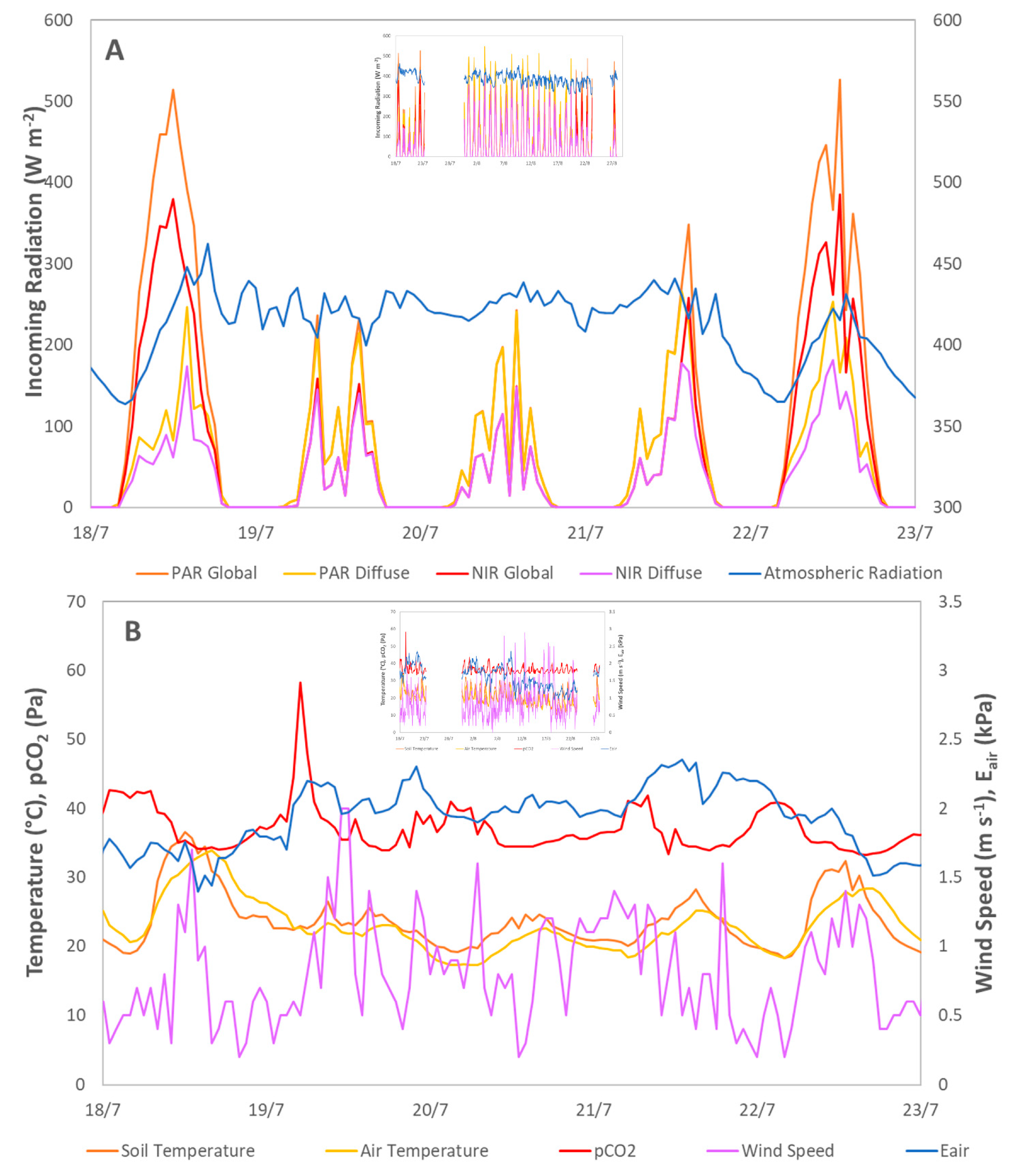


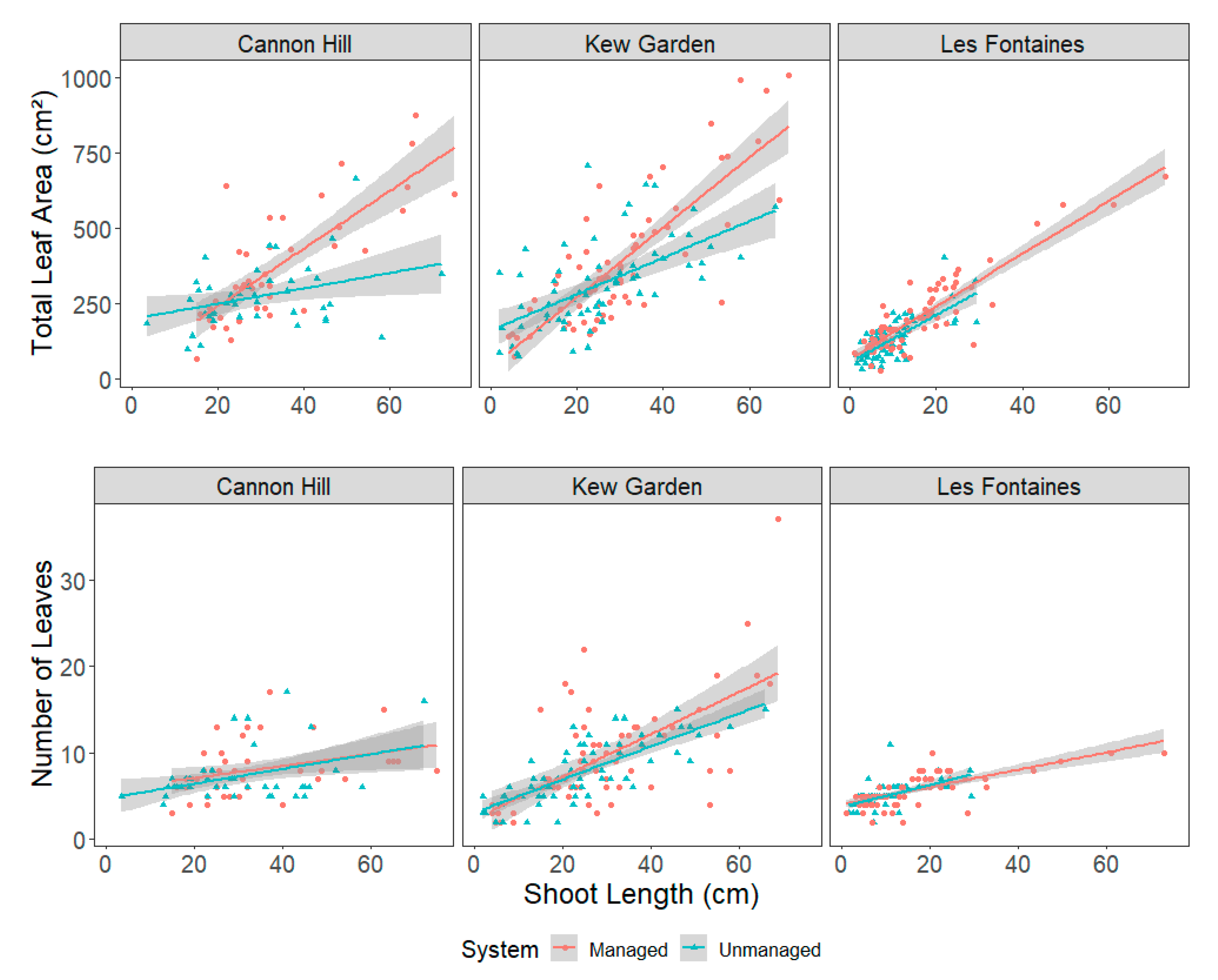
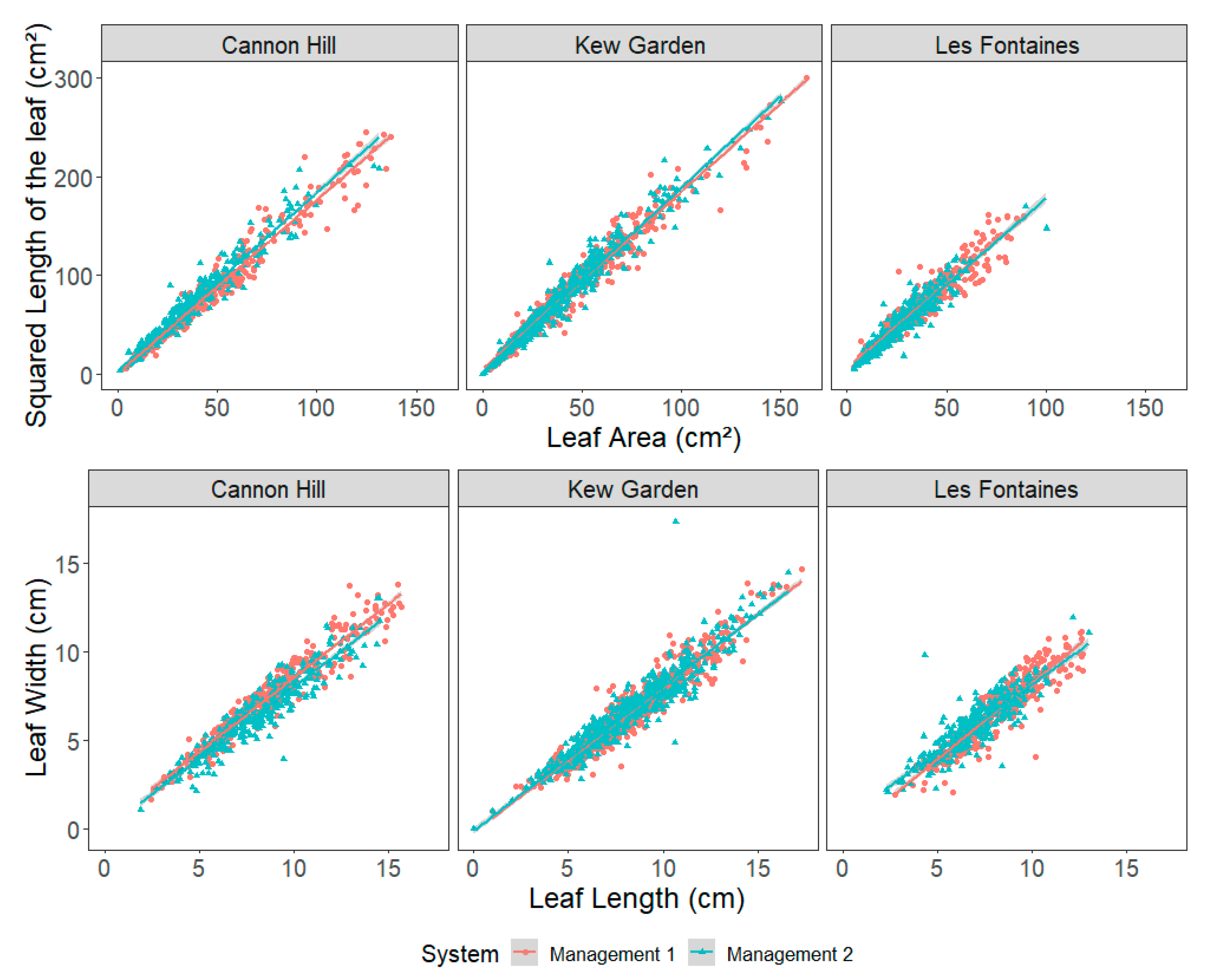
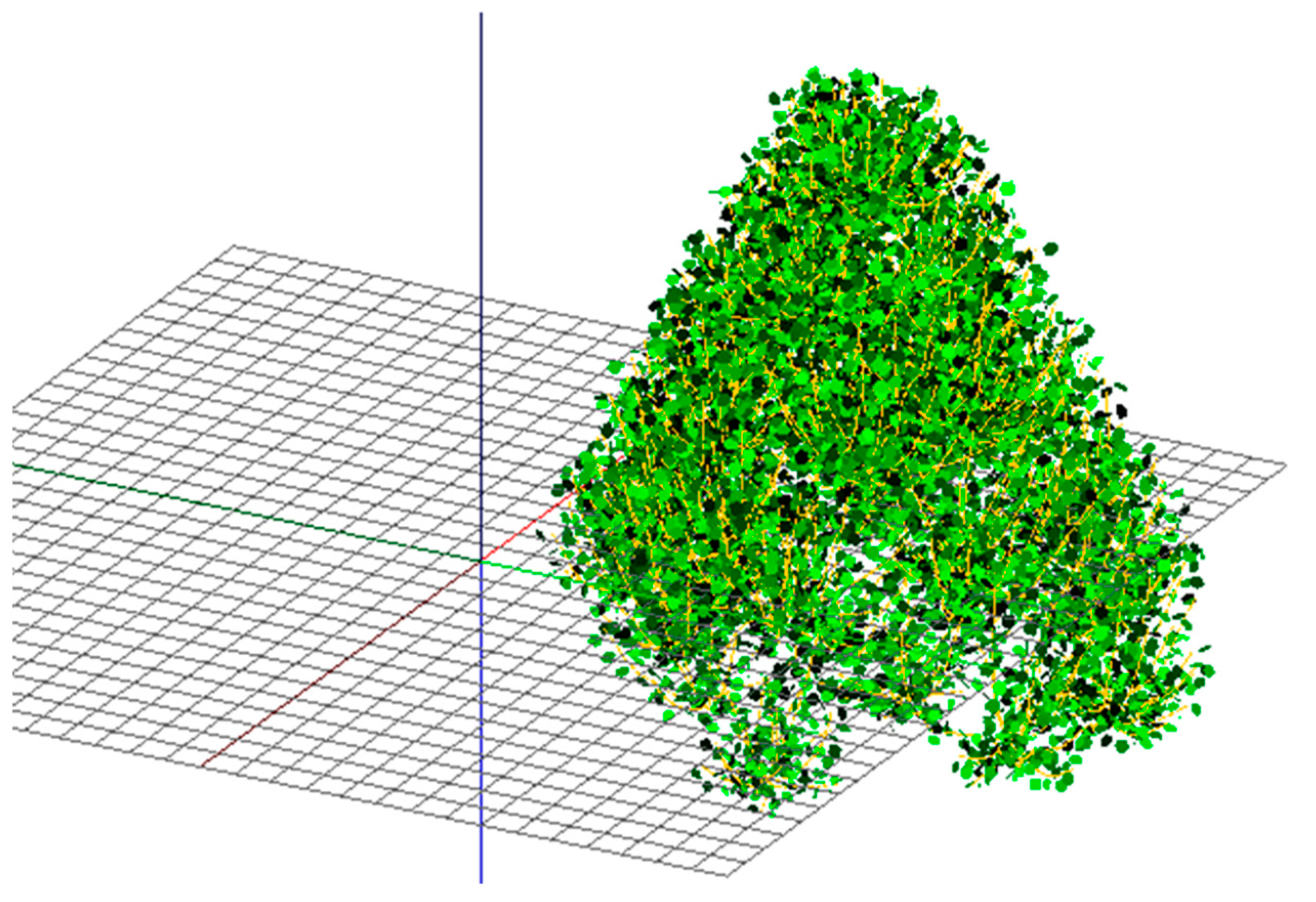
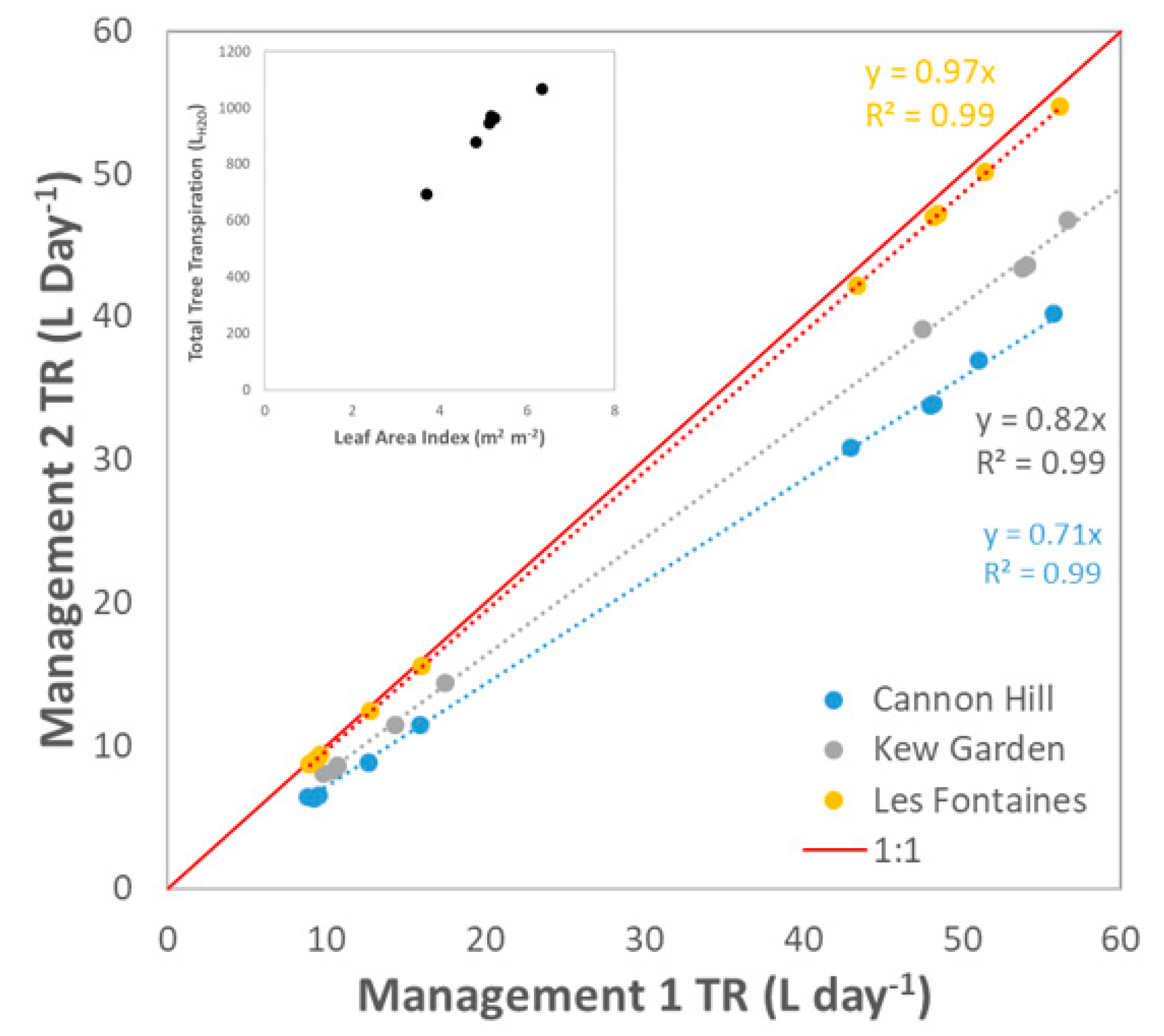
| Park, City | Lat, Long | Land and Tree Management 1 | Land and Tree Management 2 | Tree Species |
|---|---|---|---|---|
| Kew Gardens, London, UK | 51.48 N, 0.29 W | Managed (MA) | Unmanaged (UN) | Tilia platyphyllos Scop. |
| Cannon Hill, Birmingham, UK | 52.45 N, 1.90 W | Managed (MA) | Unmanaged (UN) | Tilia platyphyllos Scop. |
| Les Fontaines, Gouvieux, FR | 49.19 N, 2.45 E | Managed (MA) | Highly managed (HM) | Tilia cordata Mill. |
| Site | Dates | Events | Shoots | Leaves |
|---|---|---|---|---|
| Cannon Hill (CH) | June 2018 | 2 | 72 | 552 |
| June 2019 | 1 | 12 | 83 | |
| Kew Garden (KG) | May 2018 | 2 | 72 | 808 |
| September 2018 | 1 | 36 | 155 | |
| May 2019 | 1 | 12 | 118 | |
| July 2019 | 1 | 12 | 67 | |
| Les Fontaines (LF) | June 2018 | 1 | 36 | 160 |
| July 2018 | 1 | 36 | 198 | |
| September 2018 | 1 | 36 | 169 | |
| May 2019 | 2 | 24 | 122 | |
| June 2019 | 1 | 12 | 61 |
| Cannon Hill (CH) | Kew Garden (KG) | Les Fontaines (LF) | ||||
|---|---|---|---|---|---|---|
| MA | UN | MA | UN | HM | MA | |
| TLA (m2) | 76.9 | 41.9 | 96.0 | 65.1 | 75.9 | 74.0 |
| PLA (m2) | 14.7 | 11.4 | 15.2 | 13.5 | 14.7 | 14.5 |
| LAI (m2 m−2) | 5.2 | 3.7 | 6.3 | 4.8 | 5.2 | 5.1 |
| Voxel number | 3820 | 3592 | 3992 | 3853 | 3816 | 3814 |
| Volume (m3) | 30.6 | 28.7 | 31.9 | 30.8 | 30.5 | 30.5 |
| LADm (m2 m−3) | 2.52 | 1.46 | 3.02 | 2.11 | 2.49 | 2.43 |
| LADstd (m2 m−3) | 2.10 | 1.44 | 2.76 | 2.06 | 2.10 | 2.04 |
| STARdif | 0.30 | 0.44 | 0.26 | 0.34 | 0.34 | 0.32 |
| Sunlit Area (m2) | 14.7 | 11.4 | 15.2 | 13.5 | 14.7 | 14.5 |
| Shaded Area (m2) | 62.2 | 30.5 | 80.8 | 51.6 | 61.2 | 59.5 |
| Sunlit Area (%) | 19% | 27% | 16% | 21% | 19% | 20% |
| Shaded Area (%) | 81% | 73% | 84% | 79% | 81% | 80% |
| Min λE (MJ day−1) | 2 | 1 | 2 | 2 | 2 | 2 |
| Max λE (MJ day−1) | 138 | 100 | 153 | 126 | 139 | 135 |
Publisher’s Note: MDPI stays neutral with regard to jurisdictional claims in published maps and institutional affiliations. |
© 2021 by the authors. Licensee MDPI, Basel, Switzerland. This article is an open access article distributed under the terms and conditions of the Creative Commons Attribution (CC BY) license (https://creativecommons.org/licenses/by/4.0/).
Share and Cite
Ngao, J.; Cárdenas, M.L.; Améglio, T.; Colin, J.; Saudreau, M. Implications of Urban Land Management on the Cooling Properties of Urban Trees: Citizen Science and Laboratory Analysis. Sustainability 2021, 13, 13656. https://doi.org/10.3390/su132413656
Ngao J, Cárdenas ML, Améglio T, Colin J, Saudreau M. Implications of Urban Land Management on the Cooling Properties of Urban Trees: Citizen Science and Laboratory Analysis. Sustainability. 2021; 13(24):13656. https://doi.org/10.3390/su132413656
Chicago/Turabian StyleNgao, Jérôme, Macarena L. Cárdenas, Thierry Améglio, Jérôme Colin, and Marc Saudreau. 2021. "Implications of Urban Land Management on the Cooling Properties of Urban Trees: Citizen Science and Laboratory Analysis" Sustainability 13, no. 24: 13656. https://doi.org/10.3390/su132413656
APA StyleNgao, J., Cárdenas, M. L., Améglio, T., Colin, J., & Saudreau, M. (2021). Implications of Urban Land Management on the Cooling Properties of Urban Trees: Citizen Science and Laboratory Analysis. Sustainability, 13(24), 13656. https://doi.org/10.3390/su132413656






